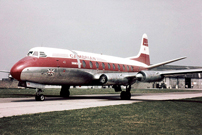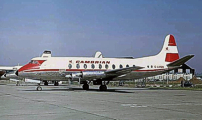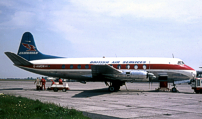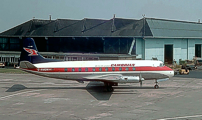
December 1963 to June 1973
Cambrian Airways
G-AMON - c/n 27 - a V.701 series Viscount
United Kingdom registered
28 December 1962
Purchased from British European Airways (BEA).
1 March 1963
Registration cancelled to British European Airways (BEA).
 Viscount illustrations by David Carter Viscount illustrations by David Carter
8 March 1963
Delivered from Teversham Airport, Cambridge, England to Rhoose Airport, Cardiff, South Glamorgan, Wales after modifications, servicing and a full repaint in Cambrian Airways livery by Marshall's.
It was flown by Captain Kenneth Wakefield.
18 March 1963
Registered to Cambrian Airways Ltd.
1 April 1963
Operated the first service to London Airport (Heathrow), Middlesex, England from Speke Airport, Liverpool, England replacing the BEA service that ceased operating the service the previous day.
26 May 1963
Operated the first scheduled Cambrian Airways Viscount service from Speke Airport, Liverpool, England to Jersey Airport, Channel Islands.
June 1963
Noted at Lulsgate Airport, Bristol, England still fitted with integral front 'airsteps', which were installed by BEA.
28 March 1964
Operated the first Cambrian Airways Viscount inclusive tour service from Speke Airport, Liverpool, England to Son Sant Joan Airport, Palma, Mallorca, Spain.

No.2 engine’s propeller
detached in flight
23 May 1964
The No.2 (port inner) propeller detached in flight as a result of a failure in the Rolls-Royce Dart engine's Reduction Gearbox and subsequent propeller overspeed and struck the forward fuselage, entering the toilet but causing no injury but with a sudden and localised decompression, resulting in a gash of approximately 5 to 6 feet in length by 6 inches wide.
The aircraft was flying at 19,000 feet en-route from Cardiff, Wales to Palma, Mallorca, Spain on an inclusive tour service under the command of Captain Denis Paines.
A safe landing was accomplished after an emergency diversion to Barcelona, Spain. Thankfully there were no injuries amongst the 4 crew and 59 passengers on board.
The aircraft was subsequently ferried to Marshall's at Teversham Airport, Cambridge, England on three engines for repairs with a temporary repair made to the fuselage and the No.2 engine's reduction gearbox front area blanked off.
Repaired and returned to service.
15 July 1964
Operated the first Cambrian Airways Viscount inclusive tour service from Rhoose Airport, Cardiff, South Glamorgan, Wales to Rimini Airport, Italy via Lulsgate Airport, Bristol, England.
November 1967
Cambrian Airways Limited became a wholly owned subsidiary of British Air Services (BAS).

Cambrian Airways
'White Cabin' livery
circa 1968
Painted in the Cambrian Airways 'White Cabin' livery.

Cambrian Airways
'British Air Services' livery
circa 1969
Painted in the Cambrian Airways 'British Air Services' livery.
20 August 1969
Ran off the runway at Rhoose Airport, Cardiff, South Glamorgan, Wales after landing long and aquaplaning on a service from Gerona, Spain.
It ended up going through the airport boundary fence.
There were no injuries to the 62 passengers and 4 crew on board, who were evacuated using the port door escape slides.
Recovery of the aircraft from the deep mud entailed making the aircraft as light as possible including removal of all the remaining fuel.
Wide channels were then cut in the ground down to the depth of the undercarriage wheels and WWII pierced steel planking (PSP) was laid down.
With a fire tender attached by cables to each main undercarriage leg and a tug (driven by Barrie Mortimer) attached to the nose undercarriage leg to prevent the aircraft from tipping backwards, the aircraft was slowly returned to the hard surface.
Returned to service after local repairs.

Cambrian Airways
'Blue Tail' livery
circa 1970
Painted in the Cambrian Airways 'Blue Tail' livery.
circa March 1971
Noted stored at Rhoose Airport, Cardiff, South Glamorgan, Wales.
circa August 1971
Returned to service.
September 1972
Noted stored at Rhoose Airport, Cardiff, South Glamorgan, Wales and held as a standby for BOAC leased Viscount G-AMOG (C/N 7).
January 1970 to 2 June 1973
The distinctive small 11th window on the port side behind the rear entrance door, fitted as part of the conversion to BEA high density seating configuration in the late 1950s/early 1960s, was noted as having been removed. The reason for and the date of this conversion are unknown.
Further details please to information@vickersviscount.net
2 June 1973
Rolled out at Rhoose Airport, Cardiff, South Glamorgan, Wales in full British Overseas Airways Corporation (BOAC) livery named as ‘Scottish Princess’.
3 June 1973
Leased to British Overseas Airways Corporation (BOAC).
|



